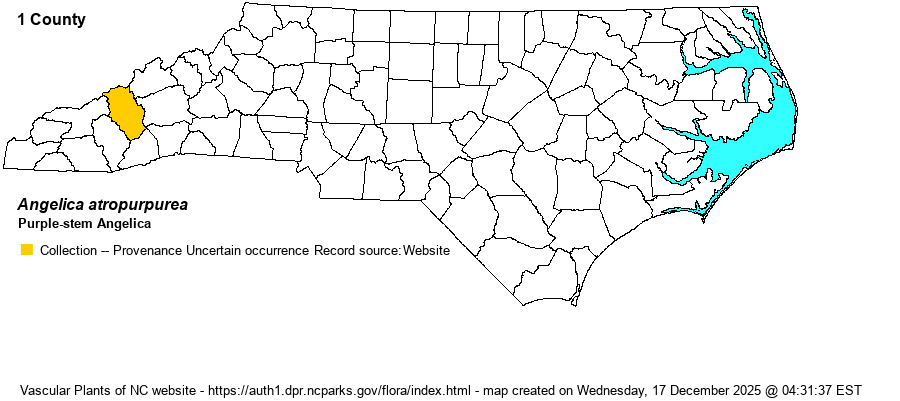| Author | L. | |
| Distribution | Collections from Haywood and Buncombe counties, and a sight report from the Doughton Park area (Alleghany or Wilkes counties) in the NCNHP database. However, as this is a Northern species, with no records for VA and unverified report(s) for eastern TN (Guide to Vascular Plants of TN, 2015), it has often been considered as probably not native in NC. In addition, the collections are historical, but the sighting -- if correct and apparently from a roadside -- is more recent. However, since there are no VA records and Doughton Park lies close to the VA border, the editors are considering this report as a likely misidentification and thus is not mapped below. Also, the Buncombe specimen is from "Biltmore" in 1899, and thus it could have been planted/cultivated at that site. The editors are being conservative and will remove that county from the map. There is a specimen from Ashe County (Culwell 558 UCAC) but is misidentified. In Haywood County there are 3 collections, from 1958, 1966, and 1975, from 3 different locations, which suggests it was well-established.
This is a Northern species ranging south only to northern DE, WV, and IA, with a few records for western NC and eastern TN (but none yet in VA). | |
| Abundance | Extremely rare to very rare, if still present. In 2022, the NCNHP moved the State Rank to SNA (SE?), owing to an uncertain and confusing status -- in terms of provenance. The Haywood County records seem to be for suitable wet habitats, but the Doughton Park report (if correct) likely is for poor habitat. The editors concur with a State Rank of SE? (Uncertain Exotic), and suggest a Watch List (W4) status, as the NCNHP formerly did. | |
| Habitat | This is a wetland species, generally found in openings in wet woods, wet stream banks, and other damp ground. Recent sightings, however, have been along roadsides, perhaps damp ones, as the species should be found only in wet or very damp ground. | |
| Phenology | Blooms in May and June, and fruits in July and August. | |
| Identification | This is one of the state's most robust "native" herbaceous species, growing to 5-6 feet tall or higher. It has a smooth dark purple stem. The scattered alternate leaves are very long, about 8 inches long, but all leaves are pinnately divided or doubly-pinnate divided, into numerous elliptical or lanceolate leaflets. Each leaflet is about 3-4 inches long and about 1-inch wide, with serrated margins. The large umbel at the top of the stem has 20-45 rays each with a smaller umbel, and each ray (umbel stem) is about 2 inches long and spreading, such that the entire umbel is about 6 inches across in a shallowly rounded dome. The flowers are white. Despite this being what should be an obvious identification, the much more numerous A. triquinata is also found in the mountains; it is smaller, up to about 4 feet tall, is not quite as deeply dissected, the leaflets tend to have acuminate tips (as opposed to acute in this species), and it has fewer ray and small umbels (13-25 as opposed to 20-45 in A. atropurpurea). Lastly, A. atropurpurea has leaflets with a hyaline margin (a colorless and smooth narrow band along the edge of a leaf -- almost like a fingernail) whereas A. triquinata has a ciliate margin. You will need to hold a leaflet up to light and examine in a hand lens to see a hyaline margin. Do not confuse these with Heracleum maximum, which is very robust but has leaflets that look like maple leaves, or with Cicuta species -- especially C. maculata, which can be locally common in wet ground in the mountains. | |
| Taxonomic Comments | None
| |
| Other Common Name(s) | Great Angelica | |
| State Rank | SE? | |
| Global Rank | G5 | |
| State Status | [W4] | |
| US Status | | |
| USACE-agcp | OBL link |
| USACE-emp | OBL link |

